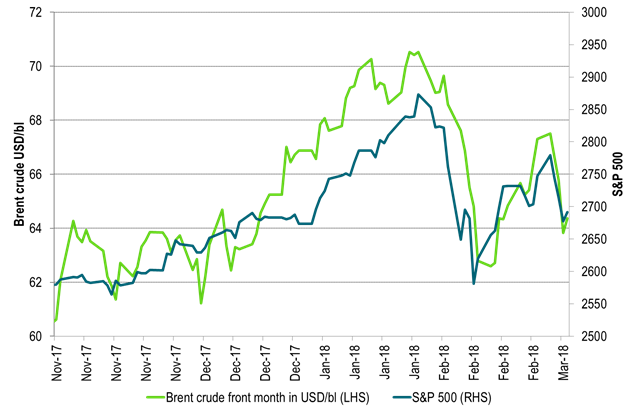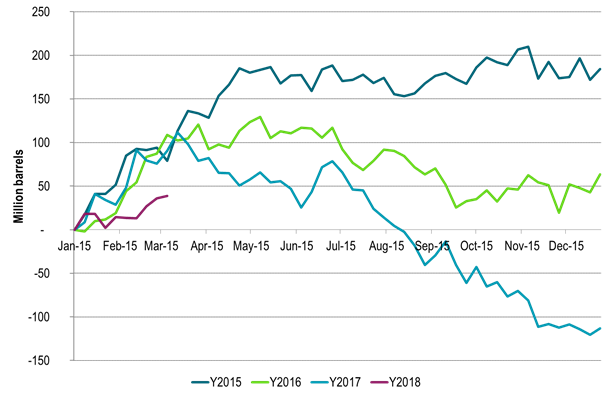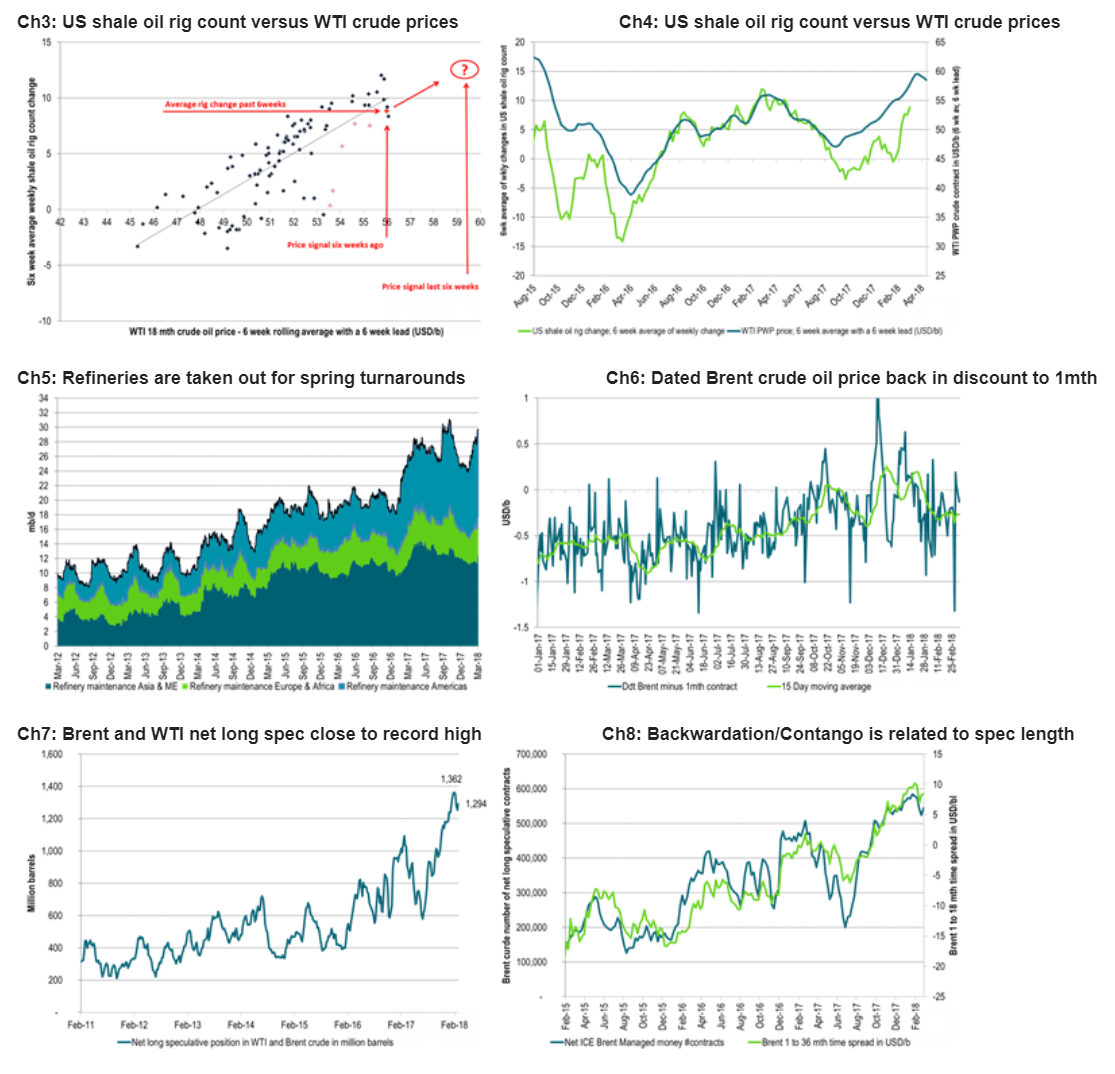Analys
More downside to come – 2018 buying opportunity sailing up

 It is very clear that Brent crude oil has followed the general risk-on/risk-off movements in global equities so far this year. The catalyst and the real mover of the oil price so far this year has clearly been the popping of the forever optimistic equity market which was rising and rising in a zero interest rate world with ultralow volatility. Now some kind of normality has returned with rising interest rates and a more normal level of volatility and the S&P 500 is now in its second round of sell-off so far this year.
It is very clear that Brent crude oil has followed the general risk-on/risk-off movements in global equities so far this year. The catalyst and the real mover of the oil price so far this year has clearly been the popping of the forever optimistic equity market which was rising and rising in a zero interest rate world with ultralow volatility. Now some kind of normality has returned with rising interest rates and a more normal level of volatility and the S&P 500 is now in its second round of sell-off so far this year.
This again should lead to a reduction in net long speculative positions in Brent and WTI crude contracts along with a need to reduce leverage in a more normal volatile market. But this has not yet happened. Net long speculative positions in Brent and WTI are still close to record long and only 69 million barrels shy of the recent all-time high of 1,362 million barrels. Over the week to 27 February they actually rose 40 million barrels.
We think that the current crude sell-off has not yet run its course and that Brent crude will touch down towards $58/bl. The curve will flatten but longer dated futures will also sell lower. We think that this could be the buying opportunity of the year for the consumers. Unless OPEC & Co eases back on their cuts we think there is a real risk that the Brent crude oil price moves towards $85/bl later in the year.
This morning Brent crude oil front month is recovering 0.3% to $64.5/bl following three days of rapid sell-off. The S&P 500 March futures contract is however trading down 0.8% this morning which could indicate that this year’s second round sell-off in equities is not yet over. This would also mean that the ongoing sell-off in Brent crude is not yet over either given that the equity sell-off has been the main catalyst for the crude sell-off. This morning’s 0.3% gain in Brent crude is unlikely to hold out the day in the face of equity sell-off and a stronger USD. So lower Brent prices later in the day.
Our view is that the Brent crude oil contract is likely to touch down towards the $58/bl level before the current sell-off has run its course. The sell-off will mostly be hitting the front end of the crude oil curve which means that the crude oil curve will flatten. The longer dated contracts have however also been hit and are likely to be dragged somewhat lower in the day’s to come as well. We think that this is playing up to a very good buying opportunity for oil consumers which we think will be able to lock in forward crude oil contract prices at very favourable price levels.
At the moment we have rising inventories in the weekly data, rising US shale oil rig count, rising US shale oil production, increasing refinery outage for maintenance, weakening dated Brent crude oil spot price versus first month contract, a stronger USD and an ongoing sell-off in the S&P 500 index. All in a setting of a close to record net long speculative position.
However, overall oil demand is set to be strong this year as long as the global growth story is intact and not destroyed by Donald’s trade war. OPEC & Co’s production cuts are intact and helped out by involuntary production declines by several of the participants as well. Thus despite the very strong US shale oil revival we think that inventories will decline significantly also in 2018 as long as OPEC & Co sticks to their cuts.
If the group actually do stick to its cuts all through 2018 we think that global oil inventories are likely to decline an additional 100-150 million barrels in 2018. What this means is that the backwardation in the crude oil curve is likely to steepen significantly in the year to come which will push the Brent crude oil price up towards $85/bl at the end of the year.
In our view though such an outcome cannot be in the interest of OPEC & Co as it will fire up US shale oil production even more. As such it seems sensible to us that the group eases its cuts somewhat in order to avoid a Brent crude oil spike towards $85/bl later in 2018. There has however been very little to hear from the group.
Ch1: Brent crude oil front month versus the S&P 500. Oil thrown around by equities
Ch2: Global weekly inventory data – Soon to head lower again by mid- to late March
Ticking higher in January for yet another year. Up 38 million barrels first 10 weeks of this year. Up 112 million barrels first 10 weeks of 2017. Up 127 million barrels first 10 weeks of 2016. So much softer upturn this year. Soon turn to declines again.
If past two years’ pattern is to repeat then global inventories will start to turn to declines again by mid-March, late March
US shale oil rig count table:
Analys
Crude stocks fall again – diesel tightness persists

U.S. commercial crude inventories posted another draw last week, falling by 2.4 million barrels to 418.3 million barrels, according to the latest DOE report. Inventories are now 6% below the five-year seasonal average, underlining a persistently tight supply picture as we move into the post-peak demand season.

While the draw was smaller than last week’s 6 million barrel decline, the trend remains consistent with seasonal patterns. Current inventories are still well below the 2015–2022 average of around 449 million barrels.
Gasoline inventories dropped by 1.2 million barrels and are now close to the five-year average. The breakdown showed a modest increase in finished gasoline offset by a decline in blending components – hinting at steady end-user demand.
Diesel inventories saw yet another sharp move, falling by 1.8 million barrels. Stocks are now 15% below the five-year average, pointing to sustained tightness in middle distillates. In fact, diesel remains the most undersupplied segment, with current inventory levels at the very low end of the historical range (see page 3 attached).
Total commercial petroleum inventories – including crude and products but excluding the SPR – fell by 4.4 million barrels on the week, bringing total inventories to approximately 1,259 million barrels. Despite rising refinery utilization at 94.6%, the broader inventory complex remains structurally tight.
On the demand side, the DOE’s ‘products supplied’ metric – a proxy for implied consumption – stayed strong. Total product demand averaged 21.2 million barrels per day over the last four weeks, up 2.5% YoY. Diesel and jet fuel were the standouts, up 7.7% and 1.7%, respectively, while gasoline demand softened slightly, down 1.1% YoY. The figures reflect a still-solid late-summer demand environment, particularly in industrial and freight-related sectors.
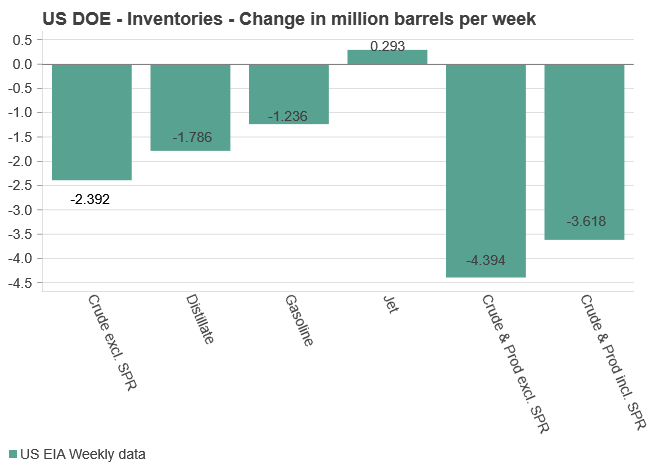

Analys
Increasing risk that OPEC+ will unwind the last 1.65 mb/d of cuts when they meet on 7 September

Pushed higher by falling US inventories and positive Jackson Hall signals. Brent crude traded up 2.9% last week to a close of $67.73/b. It traded between $65.3/b and $68.0/b with the low early in the week and the high on Friday. US oil inventory draws together with positive signals from Powel at Jackson Hall signaling that rate cuts are highly likely helped to drive both oil and equities higher.

Ticking higher for a fourth day in a row. Bank holiday in the UK calls for muted European session. Brent crude is inching 0.2% higher this morning to $67.9/b which if it holds will be the fourth trading day in a row with gains. Price action in the European session will likely be quite muted due to bank holiday in the UK today.
OPEC+ is lifting production but we keep waiting for the surplus to show up. The rapid unwinding of voluntary cuts by OPEC+ has placed the market in a waiting position. Waiting for the surplus to emerge and materialize. Waiting for OECD stocks to rise rapidly and visibly. Waiting for US crude and product stocks to rise. Waiting for crude oil forward curves to bend into proper contango. Waiting for increasing supply of medium sour crude from OPEC+ to push sour cracks lower and to push Mid-East sour crudes to increasing discounts to light sweet Brent crude. In anticipation of this the market has traded Brent and WTI crude benchmarks up to $10/b lower than what solely looking at present OECD inventories, US inventories and front-end backwardation would have warranted.
Quite a few pockets of strength. Dubai sour crude is trading at a premium to Brent crude! The front-end of the crude oil curves are still in backwardation. High sulfur fuel oil in ARA has weakened from parity with Brent crude in May, but is still only trading at a discount of $5.6/b to Brent versus a more normal discount of $10/b. ARA middle distillates are trading at a premium of $25/b versus Brent crude versus a more normal $15-20/b. US crude stocks are at the lowest seasonal level since 2018. And lastly, the Dubai sour crude marker is trading a premium to Brent crude (light sweet crude in Europe) as highlighted by Bloomberg this morning. Dubai is normally at a discount to Brent. With more medium sour crude from OPEC+ in general and the Middle East specifically, the widespread and natural expectation has been that Dubai should trade at an increasing discount to Brent. the opposite has happened. Dubai traded at a discount of $2.3/b to Brent in early June. Dubai has since then been on a steady strengthening path versus Brent crude and Dubai is today trading at a premium of $1.3/b. Quite unusual in general but especially so now that OPEC+ is supposed to produce more.
This makes the upcoming OPEC+ meeting on 7 September even more of a thrill. At stake is the next and last layer of 1.65 mb/d of voluntary cuts to unwind. The market described above shows pockets of strength blinking here and there. This clearly increases the chance that OPEC+ decides to unwind the remaining 1.65 mb/d of voluntary cuts when they meet on 7 September to discuss production in October. Though maybe they split it over two or three months of unwind. After that the group can start again with a clean slate and discuss OPEC+ wide cuts rather than voluntary cuts by a sub-group. That paves the way for OPEC+ wide cuts into Q1-26 where a large surplus is projected unless the group kicks in with cuts.
The Dubai medium sour crude oil marker usually trades at a discount to Brent crude. More oil from the Middle East as they unwind cuts should make that discount to Brent crude even more pronounced. Dubai has instead traded steadily stronger versus Brent since late May.
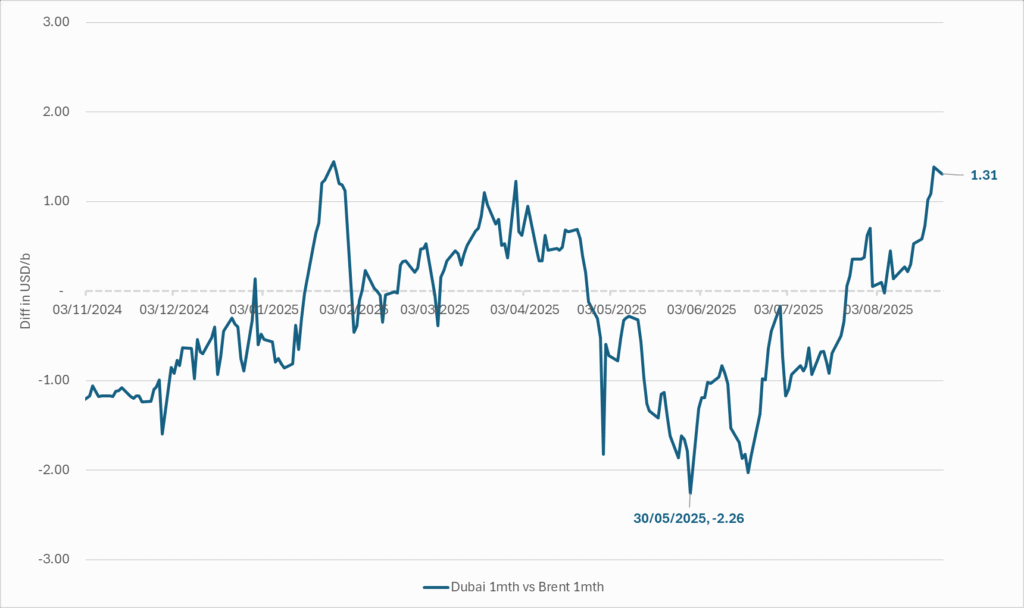
The Brent crude oil forward curve (latest in white) keeps stuck in backwardation at the front end of the curve. I.e. it is still a tight crude oil market at present. The smile-effect is the market anticipation of surplus down the road.
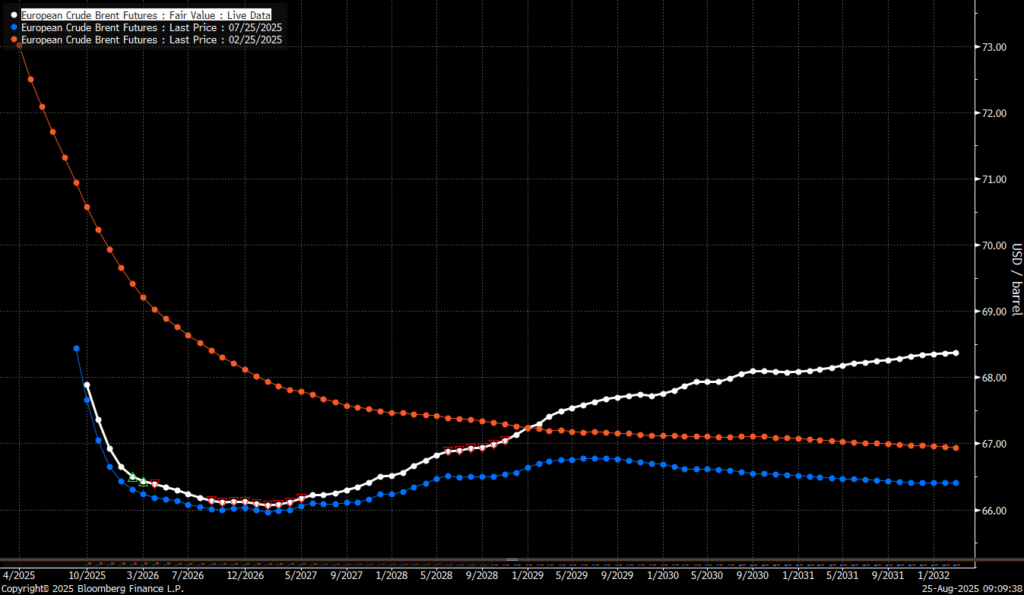
Analys
Brent edges higher as India–Russia oil trade draws U.S. ire and Powell takes the stage at Jackson Hole

Best price since early August. Brent crude gained 1.2% yesterday to settle at USD 67.67/b, the highest close since early August and the second day of gains. Prices traded to an intraday low of USD 66.74/b before closing up on the day. This morning Brent is ticking slightly higher at USD 67.76/b as the market steadies ahead of Fed Chair Jerome Powell’s Jackson Hole speech later today.

No Russia/Ukraine peace in sight and India getting heat from US over imports of Russian oil. Yesterday’s price action was driven by renewed geopolitical tension and steady underlying demand. Stalled ceasefire talks between Russia and Ukraine helped maintain a modest risk premium, while the spotlight turned to India’s continued imports of Russian crude. Trump sharply criticized New Delhi’s purchases, threatening higher tariffs and possible sanctions. His administration has already announced tariff hikes on Indian goods from 25% to 50% later this month. India has pushed back, defending its right to diversify crude sourcing and highlighting that it also buys oil from the U.S. Moscow meanwhile reaffirmed its commitment to supply India, deepening the impression that global energy flows are becoming increasingly politicized.
Holding steady this morning awaiting Powell’s address at Jackson Hall. This morning the main market focus is Powell’s address at Jackson Hole. It is set to be the key event for markets today, with traders parsing every word for signals on the Fed’s policy path. A September rate cut is still the base case but the odds have slipped from almost certainty earlier this month to around three-quarters. Sticky inflation data have tempered expectations, raising the stakes for Powell to strike the right balance between growth concerns and inflation risks. His tone will shape global risk sentiment into the weekend and will be closely watched for implications on the oil demand outlook.
For now, oil is holding steady with geopolitical frictions lending support and macro uncertainty keeping gains in check.
Oil market is starting to think and worry about next OPEC+ meeting on 7 September. While still a good two weeks to go, the next OPEC+ meeting on 7 September will be crucial for the oil market. After approving hefty production hikes in August and September, the question is now whether the group will also unwind the remaining 1.65 million bpd of voluntary cuts. Thereby completing the full phase-out of voluntary reductions well ahead of schedule. The decision will test OPEC+’s balancing act between volume-driven influence and price stability. The gathering on 7 September may give the clearest signal yet of whether the group will pause, pivot, or press ahead.
-

 Nyheter3 veckor sedan
Nyheter3 veckor sedanOmgående mångmiljardfiasko för Equinors satsning på Ørsted och vindkraft
-

 Nyheter4 veckor sedan
Nyheter4 veckor sedanLundin Gold hittar ny koppar-guld-fyndighet vid Fruta del Norte-gruvan
-

 Nyheter1 vecka sedan
Nyheter1 vecka sedanMeta bygger ett AI-datacenter på 5 GW och 2,25 GW gaskraftverk
-

 Nyheter3 veckor sedan
Nyheter3 veckor sedanGuld stiger till över 3500 USD på osäkerhet i världen
-

 Analys3 veckor sedan
Analys3 veckor sedanWhat OPEC+ is doing, what it is saying and what we are hearing
-

 Nyheter4 veckor sedan
Nyheter4 veckor sedanAlkane Resources och Mandalay Resources har gått samman, aktör inom guld och antimon
-

 Nyheter1 vecka sedan
Nyheter1 vecka sedanAker BP gör ett av Norges största oljefynd på ett decennium, stärker resurserna i Yggdrasilområdet
-

 Nyheter3 veckor sedan
Nyheter3 veckor sedanLyten, tillverkare av litium-svavelbatterier, tar över Northvolts tillgångar i Sverige och Tyskland



